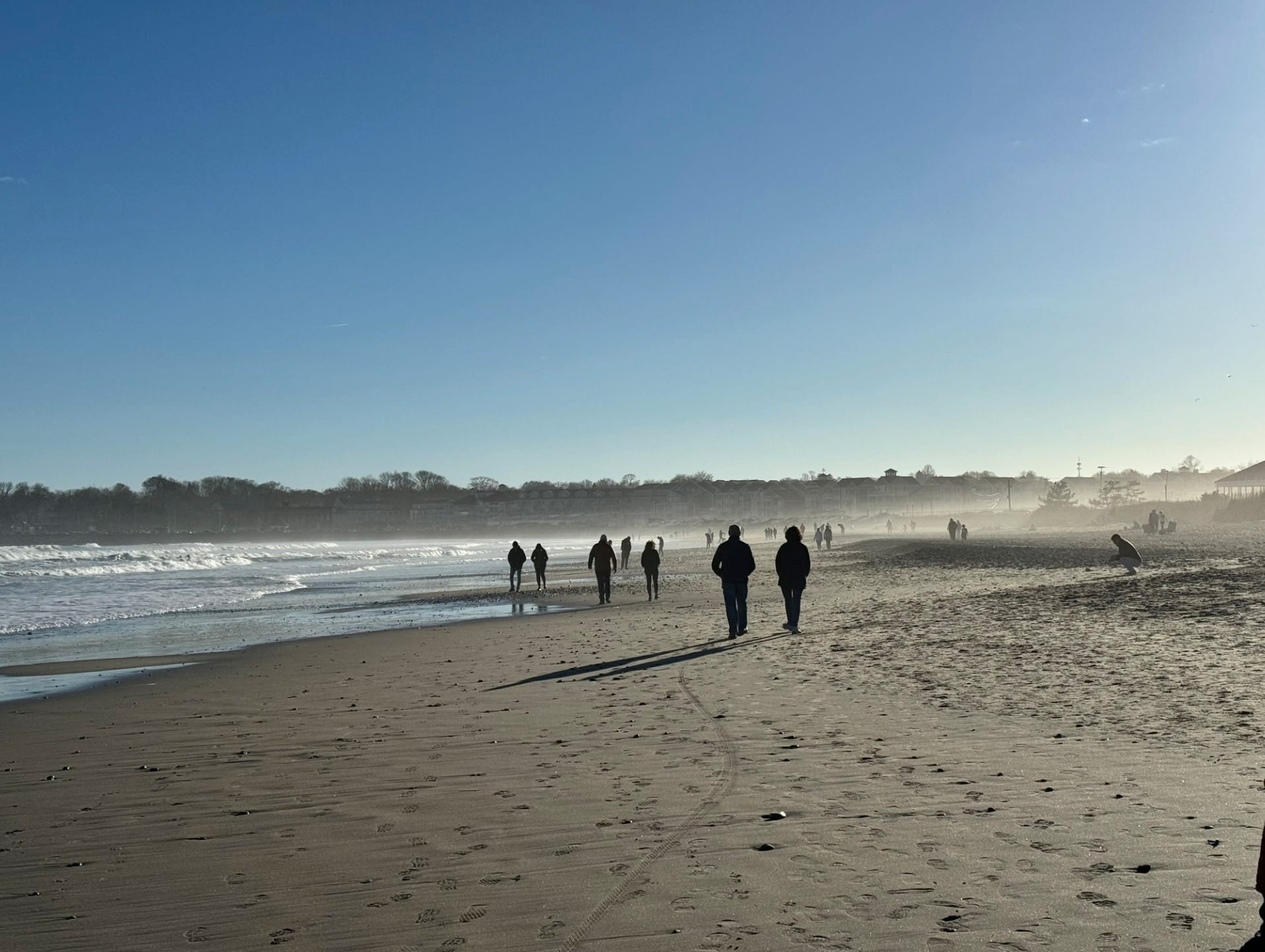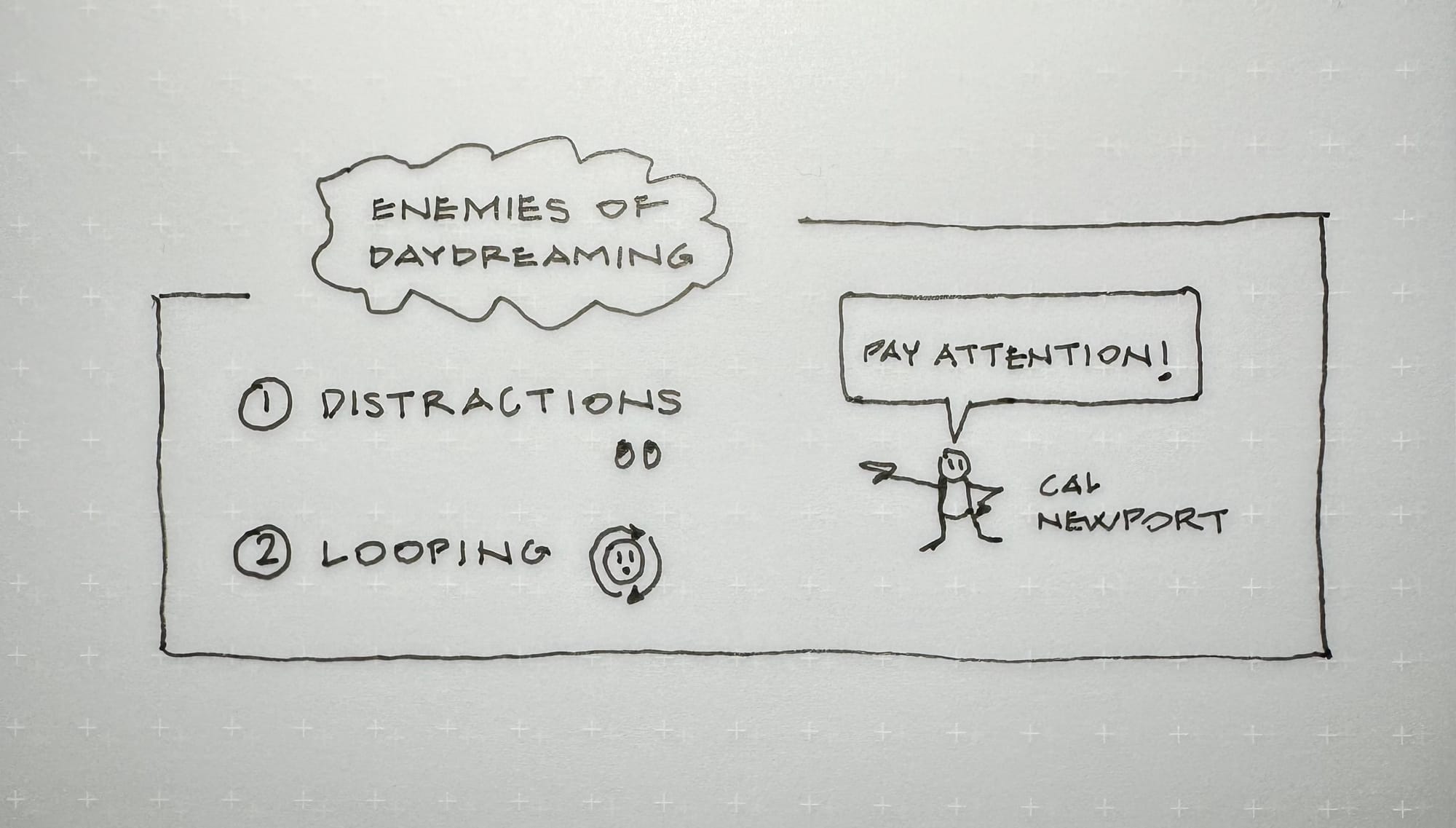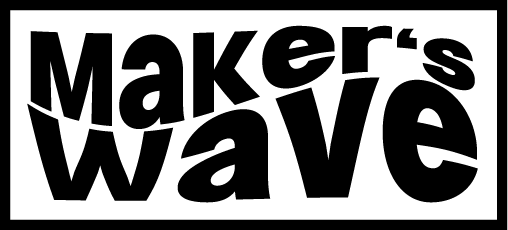Productive Daydreaming

I’ve been practicing a method called productive daydreaming. In short, it’s a conscious effort to catch your thoughts to produce ideas or solve problems.
When I first read about the word daydreaming in Jonah Lehrer’s book “Imagine” [1], I thought it was about looking out the window, zoning out, not paying attention, or being lazy.
Well, I was wrong.
In the book, we’re given the example of 3M’s Arthur Fry as a prolific wanderer. This guy invented the Post-It Note with more than 20 patents to his name. Turns out he pays attention to his daydreams and detects those moments to generate insights.
The secret to doing this is to catch your mind in the act of wandering and then channel these fleeting thoughts into creative ideas.
Jonathan Schooler, a psychologist, digs into it. He found that when we daydream, our brains aren’t just messing around. They are sifting through their database, relaxed, making connections we'd miss in the hustle of focused work. The study’s results show that those who daydream often bump into more creative ideas.
Schooler says:
"Letting your mind drift is the easy part. The hard part is maintaining enough awareness so that even when you start to daydream, you can interrupt yourself and notice a creative thought."
In my experience, maintaining that awareness has truly been the hardest part. Productive daydreaming isn't just about letting our minds loose. There is a balance we have to find. We’re trying to turn a moment of boredom into a creative session. That's the idea.
We want to find unexpected connections. We want to combine ideas. Drift too far, though, and we might lose the thread. We need to keep one foot in reality, ready to snag any creative sparks that fly.
Schooler likes a particular path for his walks, a trail weaving through the bluffs overlooking a picturesque beach in Santa Barbara. Here, the terrain is covered with chaparral and oak trees, with the ocean's waves providing a steady background hum. Each afternoon, he finds a spot to park along the Pacific Coast Highway. He deliberately leaves his iPhone in the car and sets off along the cliffside by the sea. He shares:
I never start with a plan or a mental checklist. I simply allow my thoughts to wander freely. Believe it or not, this is where my most brilliant ideas come to life.
Sounds awesome, right? But this is really tricky and needs a lot of practice. I’ve been trying to do it daily for the past few weeks. I live by the ocean and schedule daily two-mile walks on the beach to practice productive daydreaming. No phone. No music. No podcasts. No audiobooks. A notebook and a pen in my pocket to catch ideas so I can jot them down. Complete silence except for the sound of the crashing waves and the wind. I think I’m making progress, but I definitely haven’t mastered it yet.

The surroundings matter, too. Blue, as found in studies, sparks creativity. It represents openness and expansion. It relaxes the mind, making daydreaming and insight-catching easier. That's why a walk on the beach or staring into the sky can suddenly make everything click.
Cal Newport’s book “Deep Work” talks about something called The Attention Restoration Theory. [2] It suggests that nature outings can boost concentration skills. A study published in Psychological Science highlighted this through an experiment in Ann Arbor, Michigan, where participants were split into two groups for a walk—one through serene natural settings and the other through the city's lively center. The group that immersed themselves in nature showed up to a 20% improvement in focus on subsequent tasks. This is because navigating a bustling urban environment demands constant attention, while the natural world, filled with effortlessly captivating stimuli, gives our focused attention faculties a chance to recover.
Though Talking Heads frontman David Byrne famously gets his inspiration in the noisy and busy streets of New York. Apparently, he keeps windows open in his office to ensure street noise enters the room. So, some minds find solitude in noise, too.
Cal Newport, in “Deep Work,” further expands on this idea by introducing productive meditation, which is another term for productive daydreaming. Think about a problem while doing something mundane. Walking, showering, the routine tasks. It's about focusing your mental energy on a single, complex problem.
Distractions are a problem. You have to recognize when your attention is slipping away to small things unrelated to the big idea we’re looking to unlock.
Newport also mentions a concept called Looping, which I’ve been paying attention to during my walks. Our brains are attempting to take the easy route to avoid excess energy expenditure. So, instead of diving deeper into a problem, they start looping over and over again what we already know about it. When we notice this happening, we have to stop the looping and move on to the next step in the idea. Of course, it’s easier said than done.

Then there's solitude. It's got its own charm for creativity. Twyla Tharp’s book "The Creative Habit" discusses sitting alone and letting your thoughts drift. [3] It's not meditation. It's the opposite. You're not emptying your mind. You're inviting the unconscious to play. Solitude becomes a rich ground for discovery. An idea sneaks in, and suddenly, you're not alone. You've got a companion in your thoughts, a goal shaping out of the ether. This process is termed “quietness without loneliness.”
So, there is a lot here. Once I realized productive daydreaming is a mix of art and science that can be practiced and mastered, I became completely enamored with it.
It is definitely a skill. Like any skill, it takes practice. It's about navigating the fine line between free thought and focus. It's realizing that in the quiet, in the drift, there's a wealth of insight waiting to be discovered.
Have you tried productive daydreaming or some version of it? How has it worked out for you? Do you have any tips to share? I’d love to hear it in the comments of my LinkedIn post here.
[1] Jonah Lehrer - Imagine: How Creativity Works
[2] Cal Newport - Deep Work: Rules for Focused Success in a Distracted World
[3] Twyla Tharp - The Creative Habit: Learn It and Use It for Life
Maker's Wave Newsletter
Join the newsletter to receive the latest updates in your inbox.




